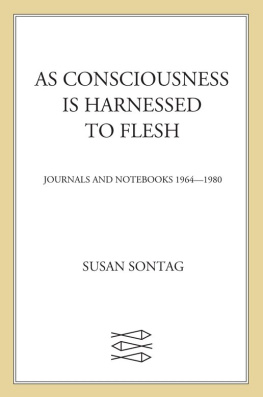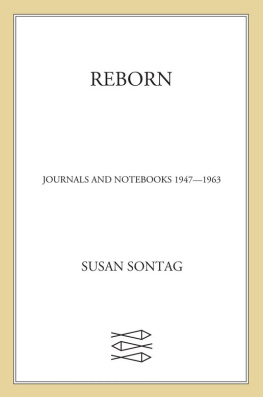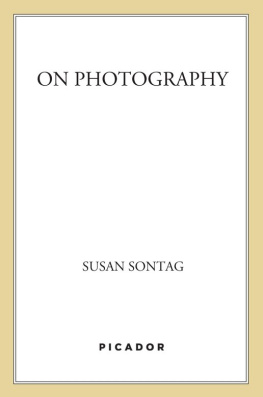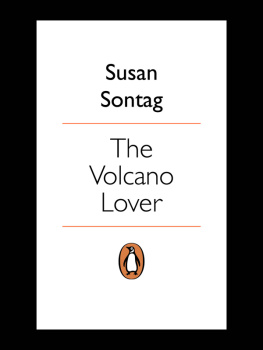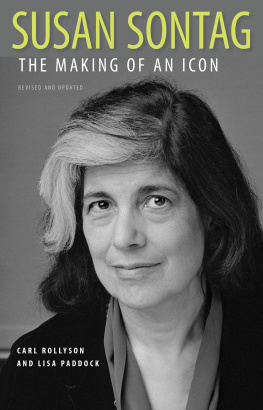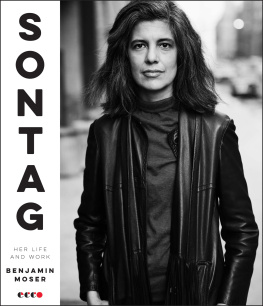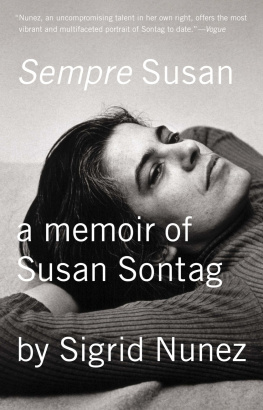Susan Sontag - Styles of Radical Will
Here you can read online Susan Sontag - Styles of Radical Will full text of the book (entire story) in english for free. Download pdf and epub, get meaning, cover and reviews about this ebook. year: 2002, publisher: Picador, genre: Art. Description of the work, (preface) as well as reviews are available. Best literature library LitArk.com created for fans of good reading and offers a wide selection of genres:
Romance novel
Science fiction
Adventure
Detective
Science
History
Home and family
Prose
Art
Politics
Computer
Non-fiction
Religion
Business
Children
Humor
Choose a favorite category and find really read worthwhile books. Enjoy immersion in the world of imagination, feel the emotions of the characters or learn something new for yourself, make an fascinating discovery.

- Book:Styles of Radical Will
- Author:
- Publisher:Picador
- Genre:
- Year:2002
- Rating:5 / 5
- Favourites:Add to favourites
- Your mark:
- 100
- 1
- 2
- 3
- 4
- 5
Styles of Radical Will: summary, description and annotation
We offer to read an annotation, description, summary or preface (depends on what the author of the book "Styles of Radical Will" wrote himself). If you haven't found the necessary information about the book — write in the comments, we will try to find it.
Styles of Radical Will — read online for free the complete book (whole text) full work
Below is the text of the book, divided by pages. System saving the place of the last page read, allows you to conveniently read the book "Styles of Radical Will" online for free, without having to search again every time where you left off. Put a bookmark, and you can go to the page where you finished reading at any time.
Font size:
Interval:
Bookmark:
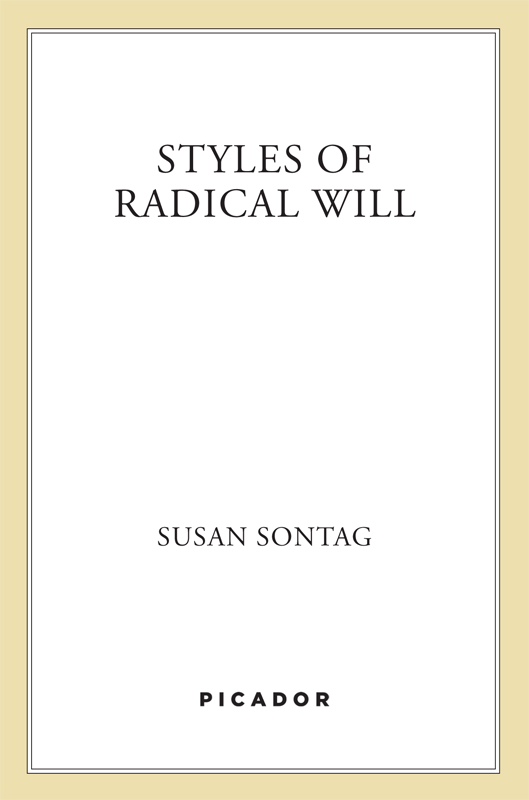

The author and publisher have provided this e-book to you for your personal use only. You may not make this e-book publicly available in any way. Copyright infringement is against the law. If you believe the copy of this e-book you are reading infringes on the authors copyright, please notify the publisher at: us.macmillanusa.com/piracy.
Contents
FOR JOSEPH CHAIKIN
I
The Aesthetics of Silence
Every era has to reinvent the project of spirituality for itself. (Spirituality = plans, terminologies, ideas of deportment aimed at resolving the painful structural contradictions inherent in the human situation, at the completion of human consciousness, at transcendence.)
In the modern era, one of the most active metaphors for the spiritual project is art. The activities of the painter, the musician, the poet, the dancer, once they were grouped together under that generic name (a relatively recent move), have proved a particularly adaptable site on which to stage the formal dramas besetting consciousness, each individual work of art being a more or less astute paradigm for regulating or reconciling these contradictions. Of course, the site needs continual refurbishing. Whatever goal is set for art eventually proves restrictive, matched against the widest goals of consciousness. Art, itself a form of mystification, endures a succession of crises of demystification; older artistic goals are assailed and, ostensibly, replaced; outworn maps of consciousness are redrawn. But what supplies all these crises with their energyan energy held in common, so to speakis the very unification of numerous, quite disparate activities into a single genus. At the moment when art comes into being, the modern period of art begins. From then on, any of the activities therein subsumed becomes a profoundly problematic activity, all of whose procedures and, ultimately, whose very right to exist can be called into question.
From the promotion of the arts into art comes the leading myth about art, that of the absoluteness of the artists activity. In its first, more unreflective version, the myth treated art as an expression of human consciousness, consciousness seeking to know itself. (The evaluative standards generated by this version of the myth were fairly easily arrived at: some expressions were more complete, more ennobling, more informative, richer than others.) The later version of the myth posits a more complex, tragic relation of art to consciousness. Denying that art is mere expression, the later myth rather relates art to the minds need or capacity for self-estrangement. Art is no longer understood as consciousness expressing and therefore, implicitly, affirming itself. Art is not consciousness per se, but rather its antidoteevolved from within consciousness itself. (The evaluative standards generated by this version of the myth proved much harder to get at.)
The newer myth, derived from a post-psychological conception of consciousness, installs within the activity of art many of the paradoxes involved in attaining an absolute state of being described by the great religious mystics. As the activity of the mystic must end in a via negativa, a theology of Gods absence, a craving for the cloud of unknowing beyond knowledge and for the silence beyond speech, so art must tend toward anti-art, the elimination of the subject (the object, the image), the substitution of chance for intention, and the pursuit of silence.
In the early, linear version of arts relation to consciousness, a struggle was discerned between the spiritual integrity of the creative impulses and the distracting materiality of ordinary life, which throws up so many obstacles in the path of authentic sublimation. But the newer version, in which art is part of a dialectical transaction with consciousness, poses a deeper, more frustrating conflict. The spirit seeking embodiment in art clashes with the material character of art itself. Art is unmasked as gratuitous, and the very concreteness of the artists tools (and, particularly in the case of language, their historicity) appears as a trap. Practiced in a world furnished with second-hand perceptions, and specifically confounded by the treachery of words, the artists activity is cursed with mediacy. Art becomes the enemy of the artist, for it denies him the realizationthe transcendencehe desires.
Therefore, art comes to be considered something to be overthrown. A new element enters the individual artwork and becomes constitutive of it: the appeal (tacit or overt) for its own abolitionand, ultimately, for the abolition of art itself.
The scene changes to an empty room.
Rimbaud has gone to Abyssinia to make his fortune in the slave trade. Wittgenstein, after a period as a village schoolteacher, has chosen menial work as a hospital orderly. Duchamp has turned to chess. Accompanying these exemplary renunciations of a vocation, each man has declared that he regards his previous achievements in poetry, philosophy, or art as trifling, of no importance.
But the choice of permanent silence doesnt negate their work. On the contrary, it imparts retroactively an added power and authority to what was broken offdisavowal of the work becoming a new source of its validity, a certificate of unchallengeable seriousness. That seriousness consists in not regarding art (or philosophy practiced as an art form: Wittgenstein) as something whose seriousness lasts forever, an end, a permanent vehicle for spiritual ambition. The truly serious attitude is one that regards art as a means to something that can perhaps be achieved only by abandoning art; judged more impatiently, art is a false way or (the word of the Dada artist Jacques Vach) a stupidity.
Though no longer a confession, art is more than ever a deliverance, an exercise in asceticism. Through it, the artist becomes purifiedof himself and, eventually, of his art. The artist (if not art itself) is still engaged in a progress toward the good. But whereas formerly the artists good was mastery of and fulfillment in his art, now the highest good for the artist is to reach the point where those goals of excellence become insignificant to him, emotionally and ethically, and he is more satisfied by being silent than by finding a voice in art. Silence in this sense, as termination, proposes a mood of ultimacy antithetical to the mood informing the self-conscious artists traditional serious use of silence (beautifully described by Valry and Rilke): as a zone of meditation, preparation for spiritual ripening, an ordeal that ends in gaining the right to speak.
So far as he is serious, the artist is continually tempted to sever the dialogue he has with an audience. Silence is the furthest extension of that reluctance to communicate, that ambivalence about making contact with the audience which is a leading motif of modern art, with its tireless commitment to the new and/or the esoteric. Silence is the artists ultimate other-worldly gesture: by silence, he frees himself from servile bondage to the world, which appears as patron, client, consumer, antagonist, arbiter, and distorter of his work.
Still, one cannot fail to perceive in this renunciation of society a highly social gesture. The cues for the artists eventual liberation from the need to practice his vocation come from observing his fellow artists and measuring himself against them. An exemplary decision of this sort can be made only after the artist has demonstrated that he possesses genius and exercised that genius authoritatively. Once he has surpassed his peers by the standards which he acknowledges, his pride has only one place left to go. For, to be a victim of the craving for silence is to be, in still a further sense, superior to everyone else. It suggests that the artist has had the wit to ask more questions than other people, and that he possesses stronger nerves and higher standards of excellence. (That the artist can persevere in the interrogation of his art until he or it is exhausted scarcely needs proving. As Ren Char has written, No bird has the heart to sing in a thicket of questions.)
Font size:
Interval:
Bookmark:
Similar books «Styles of Radical Will»
Look at similar books to Styles of Radical Will. We have selected literature similar in name and meaning in the hope of providing readers with more options to find new, interesting, not yet read works.
Discussion, reviews of the book Styles of Radical Will and just readers' own opinions. Leave your comments, write what you think about the work, its meaning or the main characters. Specify what exactly you liked and what you didn't like, and why you think so.

